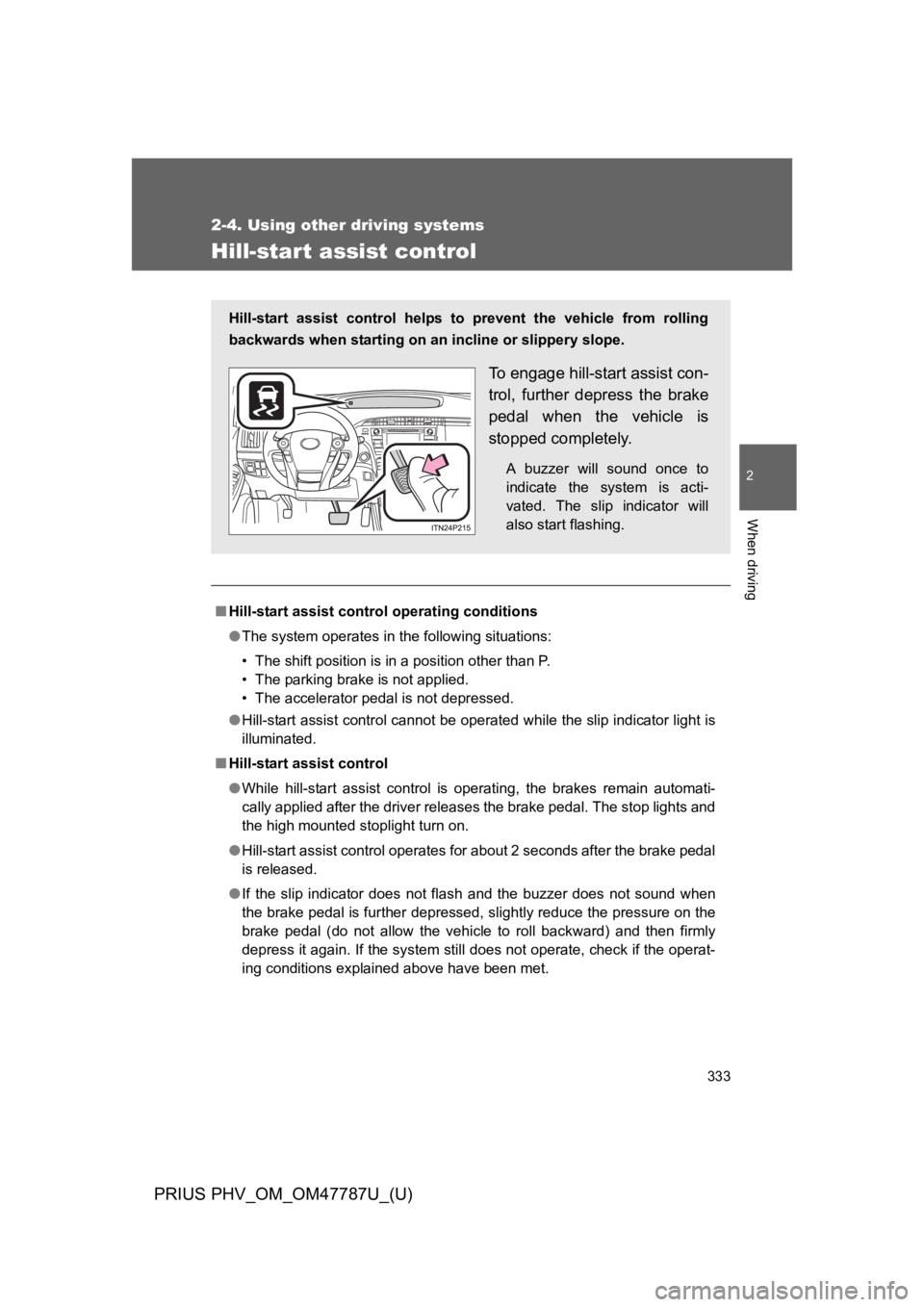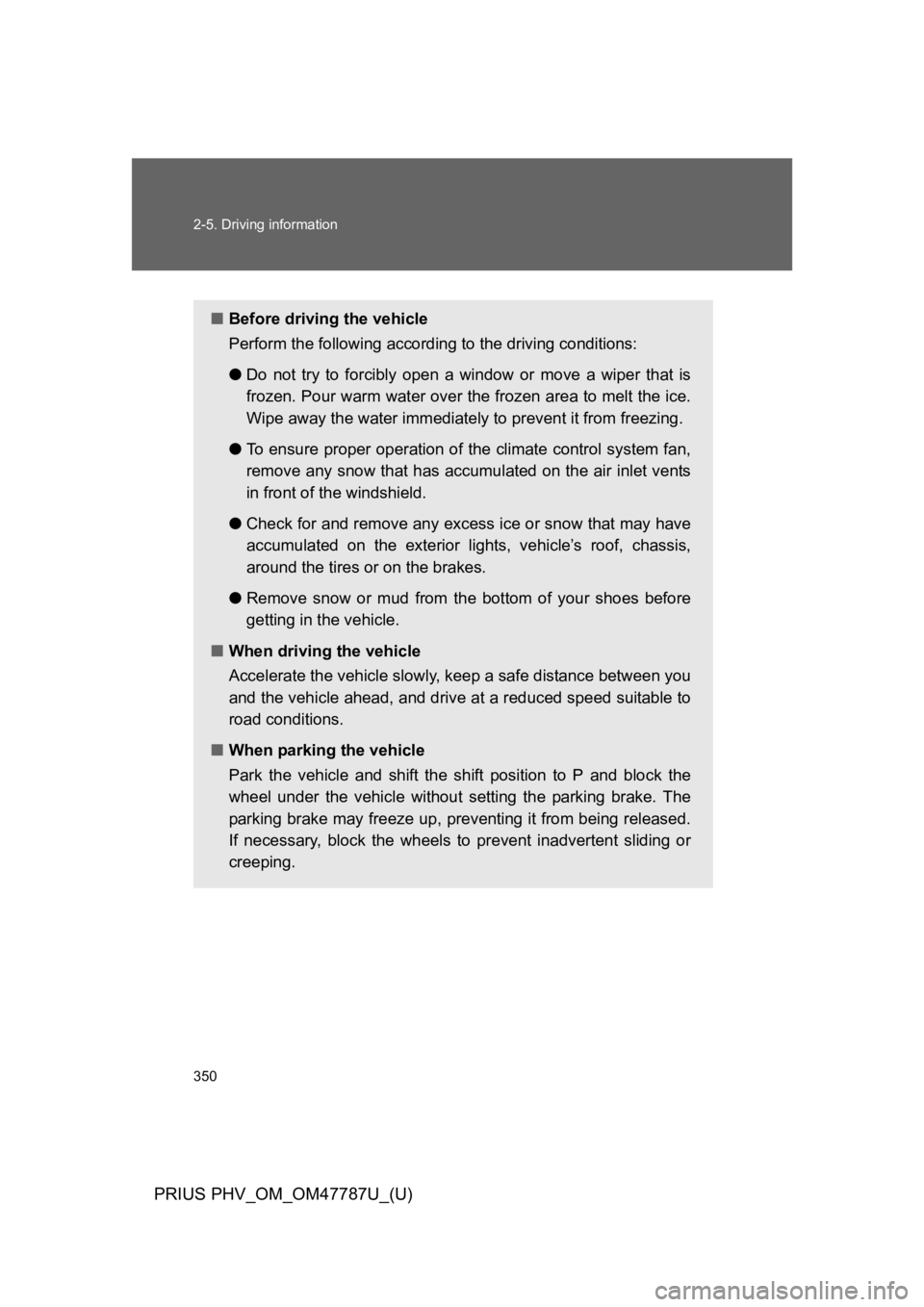Page 331 of 704
305
2-3. Operating the lights and windshield wipers
PRIUS PHV_OM_OM47787U_(U)
2
When driving
■The rear window wiper and washer can be operated when
The “POWER” switch is in ON mode.
■If no washer fluid sprays
Check that the washer nozzle is not blocked if there is washer fluid in the
washer fluid reservoir.
Ty p e B
Intermittent window
wiper operation
Normal window wiper
operation
Washer/wiper dual
operation
Washer/wiper dual
operation
Page 332 of 704
306
2-3. Operating the lights and windshield wipers
PRIUS PHV_OM_OM47787U_(U)
NOTICE
■When the rear window is dry
Do not use the wiper, as it may damage the rear window.
■When the washer fluid tank is empty
Do not operate the switch continually as the washer fluid pump may over-
heat.
Page 333 of 704
307
2-3. Operating the lights and windshield wipers
PRIUS PHV_OM_OM47787U_(U)
2
When driving
Headlight cleaner switch∗
∗: If equipped
■The headlight cleaners can be operated when
The “POWER” switch is in ON mode and the headlight switch is turned on.
If equipped, the headlight switch is in the “AUTO” position and the headlight
is on.
■Windshield washer linked operation
Only for the first time when the windshield washer is operated with the
“POWER” switch in ON mode and the headlights on, the headlight cleaners
will operate once. (→P. 3 0 0 )
NOTICE
■When the washer fluid tank is empty
Do not press the switch continually as the washer fluid pump may overheat.
Washer fluid can be sprayed on the headlights.
Press the switch to clean the
headlights.
Page 349 of 704

323
2-4. Using other driving systems
PRIUS PHV_OM_OM47787U_(U)
2
When driving
■Warning lights, messages and buzzers for dynamic radar cruise con-
trol
Warning lights, warning messages and buzzers are used to indicate a sys-
tem malfunction or to inform the driver of the need for caution while driving.
■Certification
For vehicles sold in the U.S.A.
FCC ID: HYQDNMWR004
This device complies with part 15 of the FCC Rules. Operation is subject to
the following two conditions: (1) This device may not cause harmful interfer-
ence, and (2) this device must accept any interference received, including
interference that may cause undesired operation.
FCC WARNING
Changes or modifications not expressly approved by the party responsible
for compliance could void the user’s authority to operate the equipment.
Radiofrequency radiation exposure Information:
This equipment complies with FCC radiation exposure limits set forth for an
uncontrolled environment.
This equipment should be installed and operated with minimum distance of
20 cm between the radiator (antenna) and your body.
This transmitter must not be co-located or operating in conjunction with any
other antenna or transmitter.
For vehicles sold in Canada
Operation is subject to the following two conditions: (1) this device may not
cause interference, and (2) this device must accept any interference, includ-
ing interference that may cause undesired operation of the device.
Page 359 of 704

333
2-4. Using other driving systems
PRIUS PHV_OM_OM47787U_(U)
2
When driving
Hill-start assist control
■Hill-start assist control operating conditions
●The system operates in the following situations:
•The shift position is in a position other than P.
•The parking brake is not applied.
•The accelerator pedal is not depressed.
●Hill-start assist control cannot be operated while the slip indicator light is
illuminated.
■Hill-start assist control
●While hill-start assist control is operating, the brakes remain automati-
cally applied after the driver releases the brake pedal. The stop lights and
the high mounted stoplight turn on.
●Hill-start assist control operates for about 2 seconds after the brake pedal
is released.
●If the slip indicator does not flash and the buzzer does not sound when
the brake pedal is further depressed, slightly reduce the pressure on the
brake pedal (do not allow the vehicle to roll backward) and then firmly
depress it again. If the system still does not operate, check if the operat-
ing conditions explained above have been met.
Hill-start assist control helps to prevent the vehicle from rolling
backwards when starting on an incline or slippery slope.
To e n g a g e h i l l - s t a r t a s s i s t c o n -
trol, further depress the brake
pedal when the vehicle is
stopped completely.
A buzzer will sound once to
indicate the system is acti-
vated. The slip indicator will
also start flashing.
Page 365 of 704

339
2-4. Using other driving systems
PRIUS PHV_OM_OM47787U_(U)
2
When driving
■Obstacles not detected
The sensor cannot detect plastic obstacles such as traffic cones. There may
also be occasions when the sensor cannot detect pedestrians, animals,
bicycles, motorcycles, trees, or snowdrifts.
■Situations in which the pre-collision system does not function properly
The system may not function effectively in situations such as the following:
●On roads with sharp bends or uneven surfaces
●If a vehicle suddenly moves in front of your vehicle, such as at an inter-
section
●If a vehicle suddenly cuts in front of your vehicle, such as when overtak-
ing
●In inclement weather such as heavy rain, fog, snow or sand storms
●When your vehicle is skidding with the VSC system off
●When an extreme change in vehicle height occurs
●When the axis of the radar is out of adjustment
■Automatic cancelation of the pre-collision system
When a malfunction occurs due to sensor contamination, etc. that results in
the sensors being unable to detect obstacles, the pre-collision system will be
automatically disabled. In this case, the system will not activate even if there
is a collision possibility.
■When there is a malfunction in the system, or if the system is tempo-
rarily unusable
Warning lights and/or warning messages will turn on or flash. (→P. 5 3 6 , 5 4 8 )
Page 376 of 704

350
2-5. Driving information
PRIUS PHV_OM_OM47787U_(U)
■Before driving the vehicle
Perform the following according to the driving conditions:
●Do not try to forcibly open a window or move a wiper that is
frozen. Pour warm water over the frozen area to melt the ice.
Wipe away the water immediately to prevent it from freezing.
●To e n s u r e p r o p e r o p e r a t i o n o f t he climate control system fan,
remove any snow that has accumulated on the air inlet vents
in front of the windshield.
●Check for and remove any excess ice or snow that may have
accumulated on the exterior lights, vehicle’s roof, chassis,
around the tires or on the brakes.
●Remove snow or mud from the bottom of your shoes before
getting in the vehicle.
■When driving the vehicle
Accelerate the vehicle slowly, keep a safe distance between you
and the vehicle ahead, and drive at a reduced speed suitable to
road conditions.
■When parking the vehicle
Park the vehicle and shift the shift position to P and block the
wheel under the vehicle without setting the parking brake. The
parking brake may freeze up, preventing it from being released.
If necessary, block the wheels to prevent inadvertent sliding or
creeping.
Page 397 of 704

372
3-1. Using the air conditioning system and defogger
PRIUS PHV_OM_OM47787U_(U)
■Operating conditions
The system will only operate if all of the following conditions are met:
●The shift position is in P.
●The “POWER” switch is OFF.
●All doors are closed.
●The hood is closed.
●The brake pedal is not being depressed.
■When leaving the vehicle
●Check that the headlights are switched to either off or “AUTO”.
●Check that the wiper switch is turned off.
●Check that all windows are closed.
■Remote Air Conditioning System automatic shut-off
The system will automatically shut off under the following conditions:
●About 10 minutes have passed since operation began
●Any one of the operating conditions is not met
●There is only a slight difference between the air conditioning set temper-
ature and the inside temperature.
The system may also shut off if the charge level of the hybrid battery (trac-
tion battery) drops to low. (→P. 6 0 )
■Conditions affecting operation
The system may not start in the following situations:
●The charge level of the hybrid battery (traction battery) is low (→P. 6 0 )
●The air conditioning temperature is set at a high level or outside tempera-
ture is low
●When the hybrid system is cool (for example, after being left for a long
time in low temperatures)